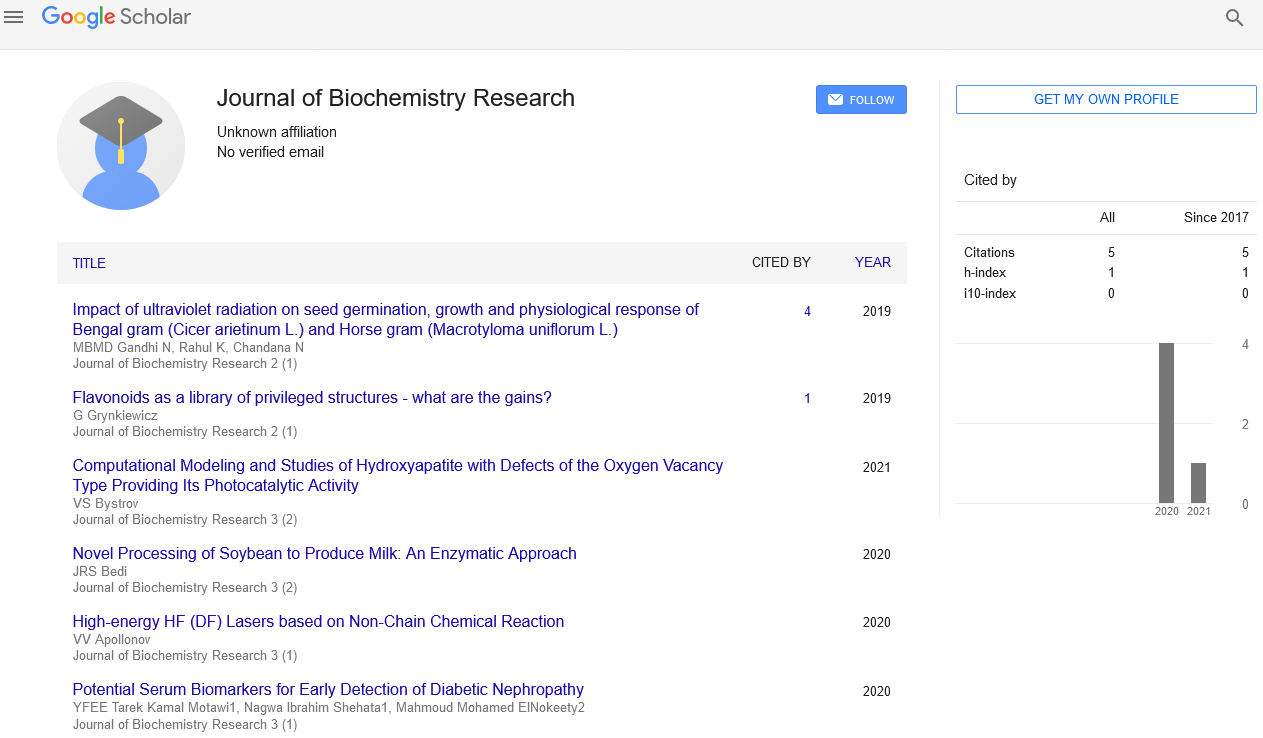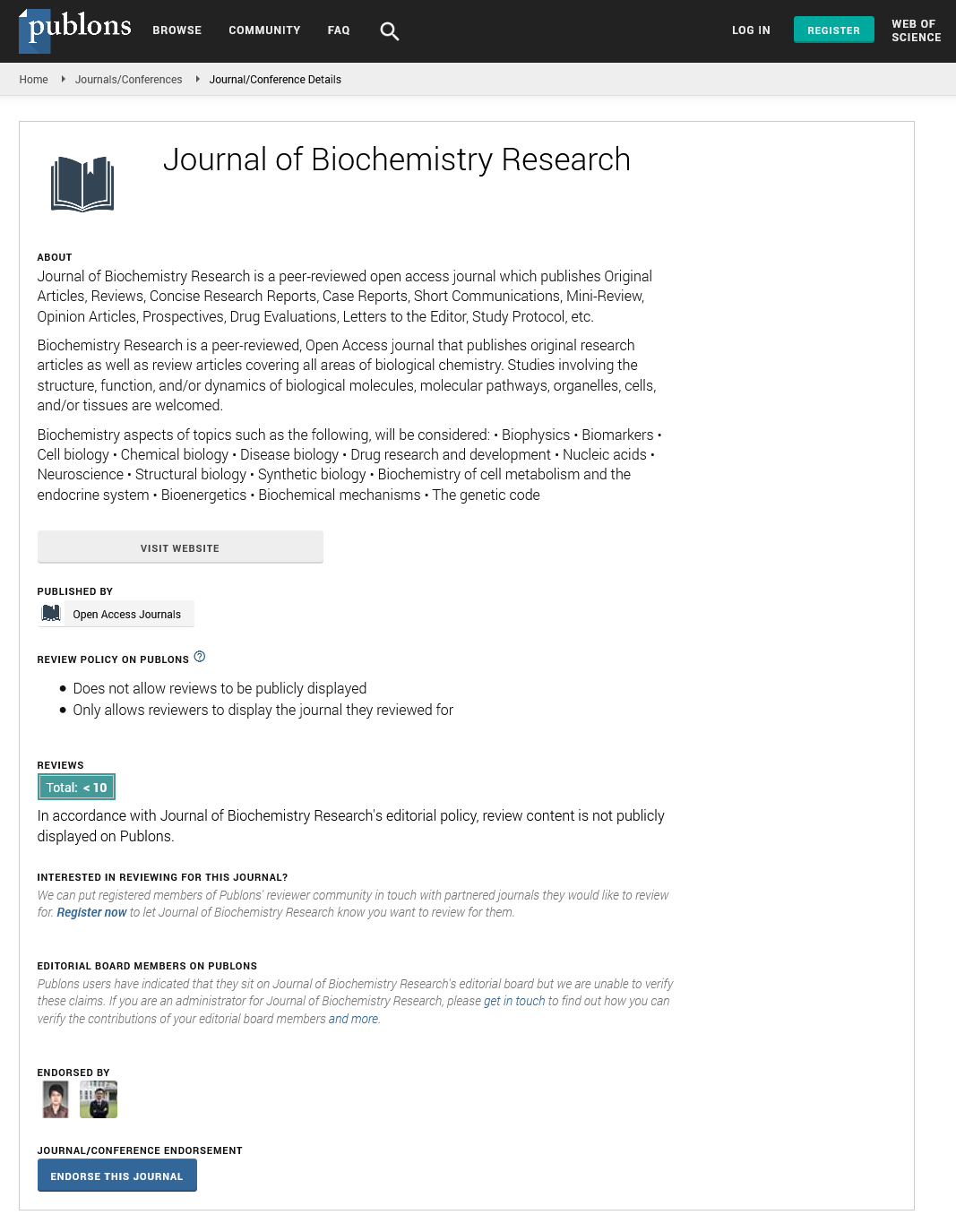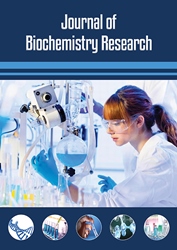Editorial - Journal of Biochemistry Research (2023) Volume 6, Issue 2
The Genetic Code: Basis Fundamental of All Life on Earth
Dr. Ragini Pal*
Department of Biochemistry, Genetic Codes, University of IRSS, India
Department of Biochemistry, Genetic Codes, University of IRSS, India
E-mail: pal.ragini@gmail.com
Received: 03-April-2023, Manuscript No. oabr-23-96578; Editor assigned: 05-April-2023, PreQC No. oabr-23- 96578; Reviewed: 19-April-2023, QC No. oabr-23-96578; Revised: 22-April-2023, Manuscript No. oabr-23-96578 (R); Published: 29-April-2023; DOI: 10.37532/ oabr.2023.6(2).23-25
Abstract
The genetic code is the fundamental basis of all life on Earth. It is the set of instructions that determines the traits, characteristics, and behavior of all living organisms. The genetic code is encoded in the DNA (Deoxyribonucleic Acid) and RNA (Ribonucleic Acid) molecules present in the cells of all living organisms. DNA is the genetic material found in the cells of all living organisms. It is a long, double-stranded helix composed of nucleotides. Each nucleotide is made up of a sugar molecule, a phosphate group, and one of four nitrogenous bases - adenine (A), guanine (G), cytosine (C), and thymine (T). The order of these bases in the DNA sequence determines the genetic code. The genetic code in DNA is passed on from one generation to another through the process of reproduction. RNA, on the other hand, is a single-stranded molecule that plays a crucial role in the process of protein synthesis. RNA is composed of nucleotides similar to those found in DNA, but instead of thymine, RNA has a base called uracil (U). RNA is transcribed from DNA in the nucleus of the cell and then transported to the cytoplasm, where it carries the genetic code to the ribosomes for protein synthesis. The genetic code is the set of instructions that govern the processes of life. It is the language of DNA and RNA, the two types of nucleic acids that are essential to all living organisms. DNA is the genetic material that is responsible for the inheritance of traits from parents to offspring, while RNA plays a key role in the synthesis of proteins, which are the building blocks of cells. The genetic code consists of four chemical building blocks, called nucleotides that make up the DNA molecule: adenine (A), cytosine (C), guanine (G), and thymine (T). In RNA, thymine is replaced by uracil (U). The sequence of these nucleotides in DNA and RNA determines the genetic information that is encoded in the molecule.
Keywords
Genetic code • Living organisms • Cytoplasm • Single-stranded molecule • Nucleotides DNA and RNA • Protein synthesis
Introduction
The genetic code is written in a language of three-letter words called codons. Each codon is composed of three nitrogenous bases in a specific order, and each codon codes for a specific amino acid. There are 64 possible codons in the genetic code, but only 20 amino acids are used to build proteins [1]. This means that some amino acids are encoded by multiple codons, while others have only one codon. The sequence of amino acids in a protein determines its structure and function. The process of protein synthesis begins with the transcription of DNA into RNA. The RNA then moves out of the nucleus and into the cytoplasm, where it binds to the ribosomes [2]. The ribosomes read the RNA sequence in groups of three nucleotides (codons) and match each codon with the corresponding amino acid. The amino acids are then linked together in a chain to form a protein. Errors in the genetic code can lead to genetic diseases and disorders. Mutations can occur when there are changes in the DNA sequence, which can result in changes in the amino acid sequence of the protein. These changes can lead to the production of abnormal proteins, which can cause diseases and disorders [3].
The genetic code is read by a process called transcription, in which the DNA sequence is used as a template to synthesize a complementary RNA molecule. This RNA molecule is then used as a template for translation, in which the information in the RNA sequence is used to synthesize a protein. The sequence of nucleotides in the RNA molecule is read in groups of three, called codons, which each code for a specific amino acid [4]. There are 64 possible codons, but only 20 amino acids are used to make proteins. Some amino acids are coded for by more than one codon, while others are coded for by only one [5]. The genetic code is highly conserved across all living organisms, from bacteria to humans. This means that the same codons code for the same amino acids in all organisms, with few exceptions. This conservation of the genetic code is evidence of the common ancestry of all living organisms [6].
Mutations in the genetic code can have profound effects on the function of proteins and the overall health of an organism. Some mutations can cause genetic disorders or increase the risk of certain diseases [7]. However, mutations can also be beneficial, leading to the development of new traits or the evolution of new species. In recent years, advances in genetics research have led to the development of new technologies, such as CRISPR-Cas9 gene editing, that allow scientists to edit the genetic code with precision. This has enormous potential for the treatment of genetic diseases and the development of new therapies [8]. The genetic code is a fundamental concept in biology, representing the information that is encoded in DNA and transcribed into RNA, ultimately leading to the synthesis of proteins. DNA is a molecule that contains the genetic instructions for the development and function of all living organisms [9]. It is composed of a sequence of nucleotides that are linked together by phosphodiester bonds, forming a doublestranded helix. RNA, on the other hand, is a single-stranded nucleic acid that is synthesized by RNA polymerase, which reads the DNA template and synthesizes a complementary RNA strand. The genetic code is the set of rules that governs the translation of the RNA sequence into a sequence of amino acids, which are the building blocks of proteins. Understanding the genetic code is crucial for advancing our understanding of genetics and biology, and has significant implications for medicine and biotechnology [10].
Conclusion
The genetic code is the foundation of all life on Earth. It is encoded in the DNA and RNA molecules present in the cells of all living organisms. The genetic code is written in a language of three-letter words (codons), and each codon codes for a specific amino acid. The sequence of amino acids in a protein determines its structure and function. Errors in the genetic code can lead to genetic diseases and disorders. Understanding the genetic code is crucial in advancing our knowledge of biology and medicine. The genetic code is a fundamental component of life, governing the processes of inheritance, protein synthesis, and evolution. Understanding the genetic code is crucial for advancing our knowledge of biology and improving human health. The genetic code refers to the chemical language that is used by living organisms to transmit and interpret genetic information. This code is primarily stored within the DNA molecules, which serve as the blueprint for life. The DNA code is then transcribed into RNA molecules, which carry the genetic information to the protein-making machinery in the cell. Through the process of translation, the sequence of nucleotides in the RNA molecule is used to assemble a specific sequence of amino acids, ultimately determining the structure and function of the resulting protein. The genetic code is highly conserved across all forms of life, but it can also be subject to mutations and genetic variation, leading to changes in the traits and characteristics of organisms. The understanding of the genetic code and its mechanisms has revolutionized our understanding of biology and has significant implications for medicine, agriculture, and biotechnology.
References
- Hamdi Nsairat. Liposomes: Structure, Composition, Types, and Clinical Applications. Heliyon. 8, 9394 (2022).
- AlSawaftah N, Pitt WG, Husseini GA et al. Dual-Targeting and Stimuli-Triggered Liposomal Drug Delivery in Cancer Treatment. ACS Pharmacol Transl Sci. 4, 1028-1049 (2021).
- Thorn, Caroline F, Doxorubicin Pathways: Pharmacodynamics and Adverse Effects. Pharmacogenet Genomics. 21, 440-446 (2011).
- Fonseca, Frederico Torres. Using ontologies for geographic information integration. Transactions in GIS.6,231-257 (2009).
- Imrie, Rob. Industrial change and local economic fragmentation: The case of Stoke-on-Trent. Geoforum. 22, 433-453 (1991).
- Kamilaris A, Prenafeata-Boldú F. Deep learning in agriculture: A survey.Comput Electron Agric.147, 70-90 (2018).
- Harrison, Paul. How shall I say it? Relating the nonrelational .Environ Plan A. 39, 590-608 (2007).
- Jackson, Peter. The multiple ontologies of freshness in the UK and Portuguese agri food sectors. Trans Inst Br Geogr. 44, 79-93 (2019).
- Tetila EC, Machado BB et al. Detection and classification of soybean pests using deep learning with UAV images. Comput Electron Agric. 179, 105836 (2020).
- Kamilaris A, Prenafeata-Boldú F. Deep learning in agriculture: A survey.Comput Electron Agric.147, 70-90 (2018).
Indexed at, Google Scholar, Crossref
Indexed at, Google Scholar, Crossref
Indexed at, Google Scholar, Crossref
Indexed at, Google Scholar, Crossref
Indexed at, Google Scholar, Crossref
Indexed at, Google Scholar, Crossref
Indexed at, Google Scholar, Crossref


